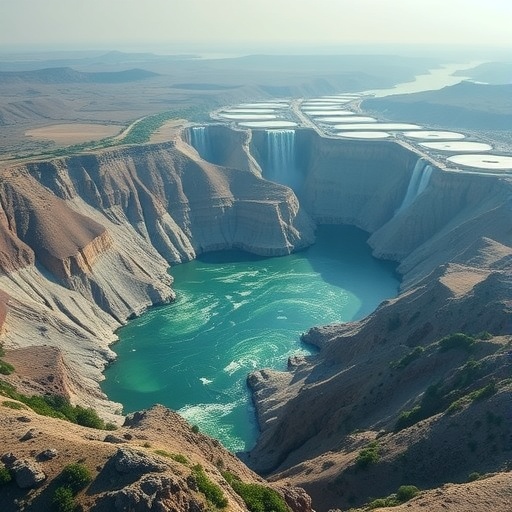In the relentless quest to comprehend Earth’s changing hydrosphere, a groundbreaking study recently published in Environmental Earth Sciences has illuminated a critical aspect that has long eluded scientists: the nonlinear behavior embedded within the total water storage trends observed via GRACE satellite data. Over two decades, the Gravity Recovery and Climate Experiment (GRACE) mission has fundamentally revolutionized our grasp of terrestrial water dynamics, yet this new work by Gunes, Klos, Lenczuk, and colleagues offers a transformative perspective that challenges previously held assumptions of linearity in water storage changes.
The GRACE satellites, launched in 2002, were designed to measure subtle variations in Earth’s gravity field, effectively allowing researchers to infer changes in the distribution and volume of water on and beneath the planet’s surface. Traditionally, trend analyses of these time series have relied on the assumption that total water storage changes proceed in a linear fashion over time, simplifying models but potentially masking underlying complex interactions. The authors of this latest study have systematically dissected the time series data to reveal a nuanced nonlinear trend that more accurately reflects the actual hydrological and geophysical processes at play.
Water storage on a global scale is influenced by a mosaic of factors including precipitation, evapotranspiration, glacial melt, groundwater extraction, and anthropogenic land use changes. By identifying nonlinear components in the GRACE data, the study accounts for abrupt shifts and oscillations that coincide with climatic events such as droughts, floods, or changes in human water use patterns. This refined understanding is crucial for water resource management, particularly in regions vulnerable to climate-induced stress or overuse.
The methodology involved advanced statistical techniques sensitive to temporal fluctuations, allowing the researchers to isolate persistent nonlinear behavior from noise and shorter-term variability. Unlike linear regression models that might underestimate the intensity or duration of certain hydrological events, the nonlinear approach captures inflection points and rate changes with greater fidelity. This results in a dynamic depiction of global water balance evolution rather than a simplistic steady trend.
One of the pivotal insights from this research is the revelation that total water storage does not simply increase or decrease at a constant pace but exhibits episodic accelerations and decelerations. These dynamics can arise from climatic variability such as ENSO (El Niño Southern Oscillation) or anthropogenic factors including groundwater depletion in critical agricultural basins. Recognizing these nonlinearities aids in forecasting future water availability and the potential risks of shortages or floods.
Moreover, the nonlinear trend analysis sheds light on regional disparities, offering detailed assessments of areas undergoing significant hydrological change. For example, water storage depletion in arid and semi-arid regions escalates faster during drought periods than linear models suggest, prompting urgent reassessment of water management policies. Conversely, replenishment phases post-rainfall events may occur more rapidly, impacting flood risk models.
Incorporating this comprehensive nonlinear perspective also has profound implications for climate change studies. Water storage trends are integrally linked to coupled climate–hydrology feedback loops. As global temperatures rise, the frequency and intensity of extreme weather events that influence water storage are anticipated to alter, meaning that models must adapt to reflect the inherently nonlinear responses observed in empirical data.
The study’s implications extend beyond purely scientific domains, reaching policymakers and stakeholders reliant on accurate hydrological data. For instance, the identification of accelerating trends in groundwater depletion necessitates immediate intervention to prevent irreversible aquifer damage. Likewise, regions witnessing abrupt increases in water availability may need to revise infrastructure resilience plans to mitigate flood hazards.
This refined understanding emerges at a time when global water stress is intensifying. Nearly two billion people currently face water scarcity, and projections indicate that this number will grow alongside population and climate pressures. Tools capable of discerning the nonlinear complexities of water storage are therefore indispensable for sustainable development, agriculture, and disaster preparedness.
The authors also discuss potential enhancements to satellite missions that could further improve resolution and sensitivity to nonlinear water variations. Future satellite constellations may implement more frequent observations and integrate additional measurement techniques, such as radar or optical sensors, to corroborate and enrich gravity data interpretations.
Technically, the challenge of parsing nonlinear trends from noisy satellite data illustrates the growing importance of interdisciplinary approaches that blend geophysics, hydrology, and advanced statistics. Techniques such as wavelet analysis, machine learning algorithms, and state-space modeling are becoming standard to unravel the multi-scale variability inherent in Earth system data.
The societal value of this research lies in its capacity to inform adaptive water management strategies that anticipate rather than react to hydrological changes. By acknowledging the nonlinear nature of water storage trends, entities governing water allocation, agricultural planning, and environmental conservation can optimize resource use and minimize ecological harm.
As Earth’s water cycle continues to be perturbed by natural and anthropogenic factors, the significance of such detailed studies grows. This research fundamentally reframes the narrative on how we interpret water storage time series, injecting greater realism and complexity into global water assessments.
In conclusion, the findings by Gunes and colleagues represent a pivotal advancement in hydrological science. By embracing nonlinear analysis of GRACE satellite time series, they provide an enriched lens through which the global community can better understand, anticipate, and respond to the evolving dynamics of Earth’s vital water resources over the past two decades.
Subject of Research: Global total water storage changes and nonlinear trends in GRACE satellite time series data.
Article Title: Nonlinearity in the trend of GRACE time series: improving understanding of global total water storage changes over two decades.
Article References:
Gunes, O., Klos, A., Lenczuk, A. et al. Nonlinearity in the trend of GRACE time series: improving understanding of global total water storage changes over two decades. Environ Earth Sci 84, 384 (2025). https://doi.org/10.1007/s12665-025-12389-9
Image Credits: AI Generated




